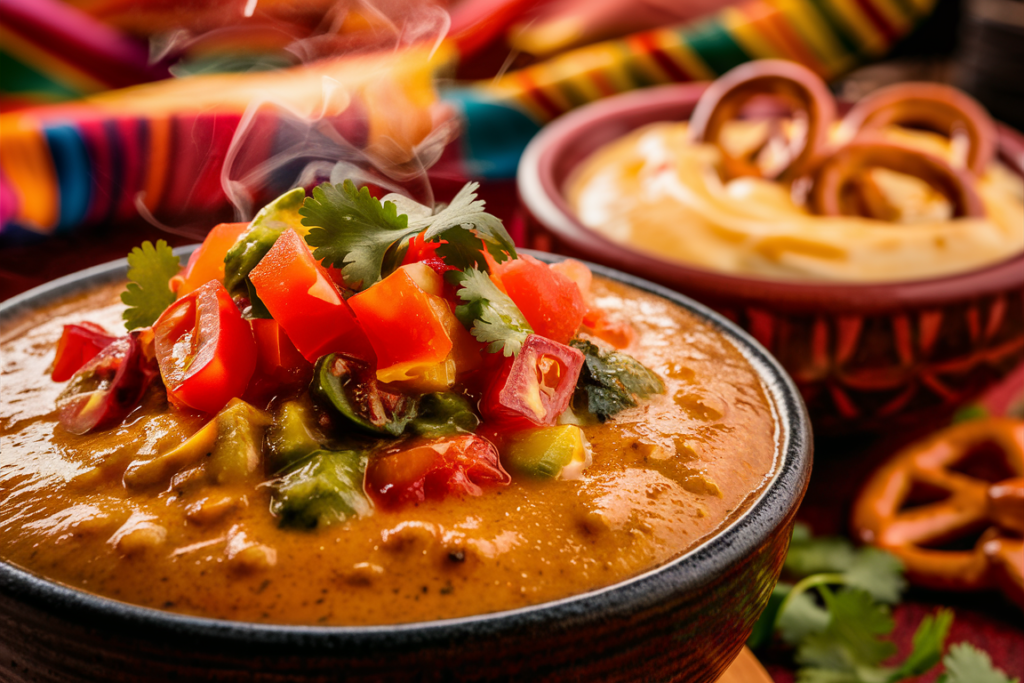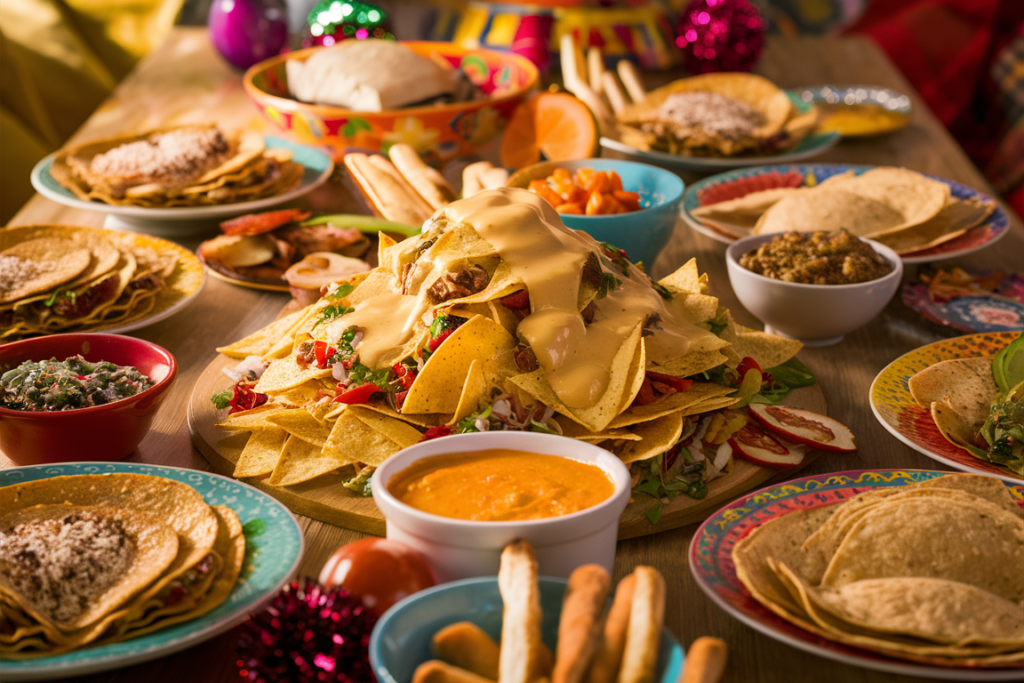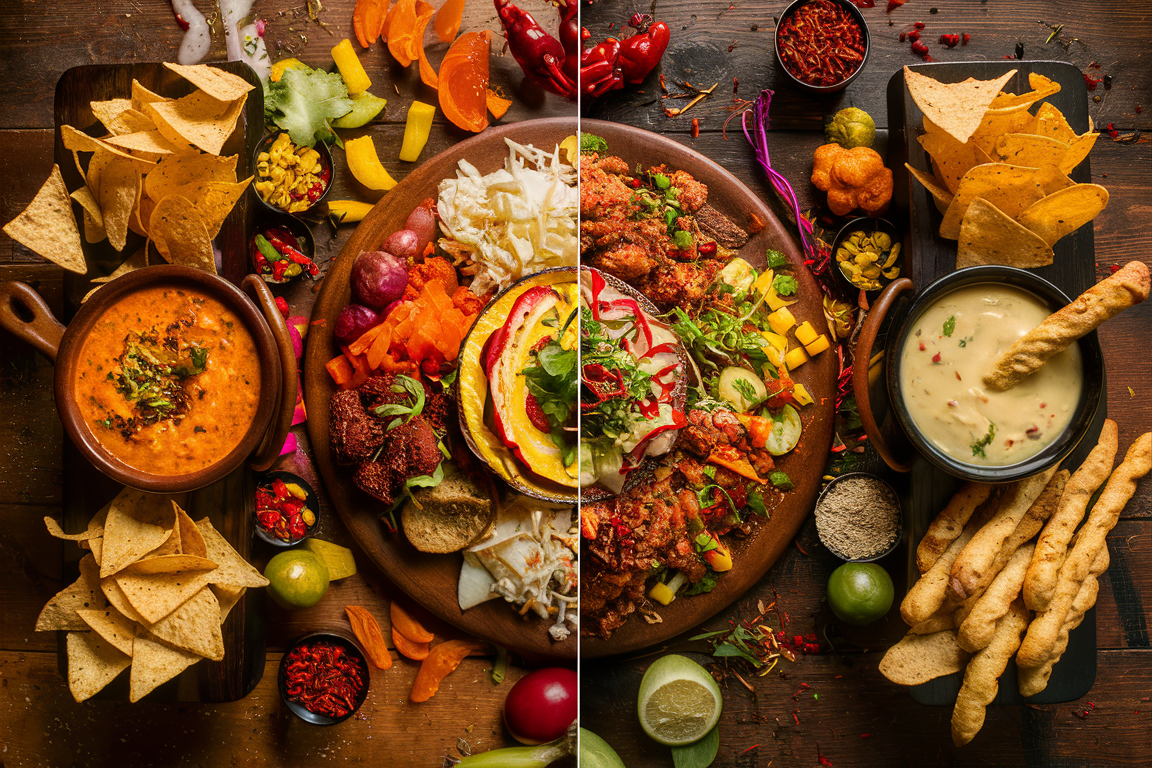Part 1: Introduction to Queso and Cheese Dip
Cheese-based dips, particularly queso vs. cheese dip, are a cornerstone of casual dining and parties worldwide. Among these, queso and cheese dip have carved distinct niches. Their widespread appeal comes from their versatility, deliciousness, and ability to adapt to countless cultural and culinary traditions. This article explores the nuances between queso and cheese dip, diving into their historical roots, ingredient differences, and cultural impact.

1.1 Defining Queso: A Tex-Mex Classic
Queso, short for “chile con queso,” is a Tex-Mex staple that combines creamy, melted cheese with spicy additions like chiles and peppers. Notably, it is often served warm, making it the perfect accompaniment for tortilla chips and other Tex-Mex dishes. In particular, its bold flavor profile is a defining characteristic, offering a perfect blend of heat and creaminess. As a result, it has become a must-have for fans of Tex-Mex cuisine.
Unlike generic cheese dips, queso embodies the spirit of its Tex-Mex origins, where fusion cuisine celebrates the marriage of traditional Mexican ingredients with American cooking methods.
1.2 What is Cheese Dip? A Broader Perspective
Cheese dip, in contrast, is a more generalized term encompassing a variety of dips made primarily from melted cheese. While queso emphasizes spice and Mexican influence, cheese dip can take many forms, from mild and creamy versions to rich blends with tangy ingredients like cream cheese or sour cream.
It’s also a culinary chameleon, adapting to regional preferences. For instance, some American cheese dips incorporate beer for a savory kick, while others lean toward smoky flavors by adding bacon.
1.3 The Popularity of Cheese-Based Dips Worldwide
Cheese dips have gone global, appearing in diverse forms across continents. For instance, in Europe, fondue offers a communal cheese-dipping experience that highlights tradition and togetherness. Meanwhile, in Asia, cheesy dips have recently gained traction as part of fusion cuisines, blending local flavors with creamy textures. Similarly, in Latin America, queso fresco and crema are frequently incorporated into local variations, adding a unique regional flair.
From game-day parties to elegant dinners, cheese-based dips are beloved for their ability to cater to diverse tastes and occasions. Consequently, their versatility continues to make them a staple in kitchens and celebrations worldwide.heir adaptability and crowd-pleasing nature.
1.4 Historical Roots of Queso: The Birthplace of Tex-Mex Cuisine
The origins of queso lie deep in the heart of Tex-Mex cuisine. This unique fusion of Mexican and American culinary traditions took root in Texas during the 19th century. With the blending of Mexican techniques and Texan ingredients like cheddar, queso evolved as a spicy, creamy creation that represented both sides of the border.
Tex-Mex food gained further prominence in the early 20th century as it became commercialized, with queso playing a leading role in popularizing this cuisine in American households.
1.5 Cheese Dip Through History: Origins and Global Influence
Cheese dips, in a broader sense, predate Tex-Mex queso. From medieval European dishes that melted cheese for sauces to 20th-century American innovations like processed cheese, the concept of cheese dips reflects human ingenuity in making food both flavorful and shareable.
Key moments in cheese dip history include:
- The Swiss invention of fondue in the 18th century.
- Mid-20th-century American cheese dips, driven by Velveeta’s rise.
- The modern globalization of cheese dips, merging with local ingredients.
1.6 Key Differences in Ingredients Between Queso and Cheese Dip
While both dips revolve around cheese, the specific ingredients often distinguish queso from cheese dip:
- Queso Ingredients:
- Melting cheeses like Monterey Jack or Velveeta.
- Chiles, jalapeños, or bell peppers for heat.
- Tomatoes and spices for depth.
- Cheese Dip Ingredients:
- A broader range, including cheddar, cream cheese, and mozzarella.
- Optional additions like garlic, herbs, and beer.
Queso emphasizes spice and creaminess, whereas cheese dip’s focus is often on richness and flavor variety.
1.7 Regional Variations of Queso in the United States and Mexico
Queso varies significantly based on its geographical location:
- In Texas, queso often features processed cheeses like Velveeta, blended with spicy chiles.
- In Northern Mexico, traditional queso includes fresher, less processed cheeses like Oaxaca or panela.
- In the Southern U.S., creative variations incorporate seafood or sausage for local flair.
These variations showcase queso’s adaptability to regional palates and ingredients.
1.8 Exploring the Versatility of Cheese Dip in Different Cultures
Cheese dips are cultural shape-shifters. Their versatility allows them to shine in various cuisines:
- Mexican Queso Fundido: A thicker, more rustic variation served with tortillas.
- American Cheese Dip: Often mild and creamy, perfect for pretzels or breadsticks.
- European Fondue: A classic communal experience featuring wine and melted cheese.
This adaptability has made cheese dips a global phenomenon, beloved for their ability to complement a wide range of foods.
1.9 The Influence of Spices and Additions: How Queso Stands Out
What sets queso apart from generic cheese dips is its bold use of spices and additions:
- Chiles give queso its signature kick.
- Cumin, paprika, and garlic add complexity.
- Optional toppings like guacamole, pico de gallo, or ground beef make queso a dynamic dish.
In contrast, many cheese dips lean toward subtlety, focusing on the creamy texture rather than bold flavors.
1.10 Why Distinguishing Between Queso and Cheese Dip Matters
Understanding the difference between queso and cheese dip isn’t just about semantics—it’s about appreciating the distinct cultural and culinary heritages they represent.
- Queso is a Tex-Mex icon, deeply rooted in the Mexican-American experience.
- Cheese dip is a versatile, global phenomenon with countless variations.
By knowing the differences, you can make better choices when pairing dips with dishes or recreating them at home.
Part 2: Comparing Ingredients and Preparation
The magic of queso and cheese dip lies not just in their flavor but also in their ingredients and how they’re prepared. While they may seem similar at a glance, the distinctions in their components and cooking techniques tell a story of culinary evolution and cultural adaptation.

2.1 Common Ingredients in Queso: Traditional Tex-Mex Recipes
At the heart of queso are the ingredients that define Tex-Mex cuisine. A traditional recipe typically includes:
- Melting Cheeses: Velveeta or Monterey Jack are popular choices due to their smooth, creamy meltability.
- Chiles: Jalapeños, serranos, or green chiles bring the heat.
- Tomatoes: Diced tomatoes add a touch of acidity and freshness.
- Spices: Paprika, cumin, and garlic powder are commonly used to create depth.
These ingredients combine to make a dip that’s rich, spicy, and versatile.
2.2 Key Components of Cheese Dip: Broader Adaptations
Unlike queso, cheese dip is less constrained by regional or cultural identity. Its ingredients can vary widely based on the intended flavor profile:
- Cheeses: Cheddar, mozzarella, or cream cheese.
- Optional Additions: Beer, mustard, or Worcestershire sauce for tangy undertones.
- Base Ingredients: Sour cream, mayonnaise, or yogurt for a creamy texture.
This flexibility allows cheese dip to pair with a wider variety of foods, from pretzels to vegetables.
Interesting fact: The use of cream cheese in dips skyrocketed in the 1950s as processed food became a mainstay in American kitchens.
2.3 The Role of Spices in Queso and Their Absence in Some Cheese Dips
Queso stands out for its liberal use of spices:
- Cumin and paprika enhance the Tex-Mex flavor profile.
- Garlic powder adds a savory note.
In contrast, many cheese dips are mild and unspiced, designed to emphasize the cheese’s natural flavors. However, this absence of spices makes some cheese dips less dynamic compared to queso.
2.4 The Use of Specific Cheeses: Velveeta, Monterey Jack, and More
Cheese selection is a defining factor in these dips:
- Queso: Velveeta is a common choice due to its processed consistency, while Monterey Jack adds a creamy yet slightly tangy taste.
- Cheese Dip: Sharp cheddar is often used for a robust flavor, while cream cheese creates a rich, spreadable texture.
The choice of cheese significantly influences the dip’s consistency and taste.
2.5 Dairy vs. Non-Dairy Elements in Cheese-Based Dips
Modern dietary trends have influenced even traditional dishes like queso and cheese dip:
- Dairy-Free Alternatives: Coconut milk, almond-based cheese, and nutritional yeast are popular substitutes.
- Health-Conscious Additions: Yogurt or low-fat cream cheese can replace heavier ingredients.
While these changes cater to dietary restrictions, they can alter the texture and flavor, making them less authentic.
2.6 Cooking Techniques: Melting, Blending, and Seasoning
The preparation process is where queso and cheese dip truly diverge:
- Queso: Often cooked on the stovetop or slow-cooker, queso requires constant stirring to achieve a smooth consistency. The addition of spices and vegetables happens during the cooking process.
- Cheese Dip: Depending on the recipe, it might simply involve blending and heating ingredients, requiring less effort.
Both methods rely on proper melting to avoid clumping and achieve the desired creamy texture.
2.7 The Addition of Chiles: A Staple in Queso, Optional in Cheese Dip
Chiles are non-negotiable in queso, providing its signature heat. Commonly used varieties include:
- Jalapeños for moderate spice.
- Serranos for a sharper, more intense kick.
Cheese dip, however, often omits chiles, making it a safer choice for those who prefer mild flavors.
2.8 Influence of Culinary Tradition: Tex-Mex vs. American Comfort Food
Queso is a hallmark of Tex-Mex cuisine, which celebrates bold flavors and fusion. Cheese dip, on the other hand, aligns more with American comfort food, where simplicity and versatility are prized. This distinction reflects the cultural identities each dish represents.
2.9 Health Considerations: Nutritional Differences
While undeniably delicious, both dips come with their own nutritional profiles:
- Queso: Often higher in fat and sodium due to processed cheeses and added spices.
- Cheese Dip: Can vary significantly; cream-based versions tend to have more calories, while low-fat adaptations may be lighter.
For health-conscious consumers, moderation is key.
2.10 The Role of Tomatoes, Peppers, and Other Vegetables
Vegetables play a supporting role in these dips:
- In queso, diced tomatoes and green peppers enhance the texture and flavor.
- In cheese dips, vegetables like onions, artichokes, or spinach can be added for variety.
These additions not only diversify the flavor but also make the dips visually appealing.
Part 3: Culinary Applications and Serving Styles
The allure of queso and cheese dip goes beyond the kitchen. These versatile creations can elevate countless dishes, whether you’re hosting a casual gathering or crafting a gourmet experience. This section explores traditional serving methods, cultural influences, and modern innovations.

3.1 Traditional Ways to Serve Queso: Tacos, Nachos, and More
Queso shines in its traditional Tex-Mex roles:
- Tacos: A drizzle of queso adds creaminess and spice, complementing proteins like chicken, beef, or fish.
- Nachos: Layered with tortilla chips, jalapeños, and toppings like guacamole or sour cream, queso acts as the binding ingredient.
- Burritos and Quesadillas: As a filling or dipping sauce, it enhances every bite.
Queso is also a popular dip for tortilla chips, often served warm at restaurants and gatherings.
3.2 Cheese Dip Pairings: Bread, Chips, and Vegetables
Cheese dip, with its broader flavor profiles, offers a wide range of pairing possibilities:
- Bread: Soft pretzels, baguettes, or crusty bread work well with creamy dips.
- Vegetables: Carrots, celery, and bell peppers provide a healthy alternative for dipping.
- Chips: Beyond tortilla chips, potato chips or pita chips are excellent companions.
This adaptability makes cheese dip a staple for parties and snack platters.
3.3 Exploring Regional Pairings: How Locale Affects Usage
The way queso and cheese dip are paired often depends on regional preferences:
- Southwest U.S.: Queso is synonymous with Tex-Mex classics like enchiladas and fajitas.
- Midwest U.S.: Cheese dips are often served with beer-infused recipes to complement local brews.
- Europe: Variations like fondue serve as a communal experience with bread and cured meats.
These regional differences showcase the cultural significance of these dips.
3.4 The Influence of Queso and Cheese Dip on Tex-Mex Cuisine
Queso is integral to the Tex-Mex identity. Its spicy, creamy consistency balances the bold flavors of Tex-Mex dishes, creating harmony on the plate. From enchiladas to fajitas, queso enhances the experience by adding texture and heat.
Cheese dip, while less specific to Tex-Mex, has inspired fusion dishes that incorporate elements of this cuisine.
3.5 Fusion Dishes Incorporating Queso and Cheese Dip
Modern chefs have embraced the versatility of these dips, incorporating them into innovative fusion dishes:
- Queso-Stuffed Burgers: A Tex-Mex twist on an American classic.
- Cheese Dip Pasta Sauce: Combining creamy cheese dip with pasta creates a rich and flavorful dish.
- Queso Tacos: Hard-shell tacos drizzled with queso for extra indulgence.
These creations highlight how queso and cheese dip transcend traditional uses.
3.6 Differences in Consistency: Thick, Creamy, or Liquid
The consistency of queso and cheese dip often determines how they’re used:
- Queso: Typically thinner and more pourable, perfect for drizzling over dishes.
- Cheese Dip: Often thicker, making it ideal for spreading or scooping.
Adjusting the ratio of liquid to cheese allows for customization based on the desired use.
3.7 Customizing Queso and Cheese Dip for Dietary Restrictions
The growing demand for dietary accommodations has led to creative variations of these dips:
- Vegan Queso: Made with cashews, nutritional yeast, and plant-based milk for a dairy-free alternative.
- Low-Fat Cheese Dip: Substituting cream cheese with yogurt or low-fat options for health-conscious consumers.
These adaptations ensure everyone can enjoy the cheesy goodness, regardless of dietary needs.
3.8 Cultural Celebrations and Cheese-Based Dishes
Cheese-based dips are often the centerpiece of celebrations:
- Cinco de Mayo: Queso takes center stage as a Tex-Mex favorite.
- Game Day: Cheese dips dominate Super Bowl spreads, paired with chips, sliders, and wings.
- Holiday Parties: Fondue-style cheese dips bring people together around a shared pot.
These traditions underscore the communal appeal of these dips.
3.9 Modern Takes on Queso and Cheese Dip in Gastronomy
In recent years, queso and cheese dip have found their way into high-end gastronomy. Chefs are experimenting with:
- Artisanal Cheeses: Using high-quality cheeses like Gruyère or goat cheese for unique flavors.
- Infused Oils and Toppings: Truffle oil or caramelized onions add gourmet flair.
- Presentation: Serving queso in edible bread bowls or hollowed-out peppers for aesthetic appeal.
These modern approaches elevate the humble dip into a fine dining experience.
3.10 Queso vs. Cheese Dip: Which One is Right for Your Dish?
Choosing between queso and cheese dip depends on the dish and occasion:
- Queso: Best for Tex-Mex dishes, spicy snacks, and bold flavors.
- Cheese Dip: Ideal for milder palates, versatile snacks, and creative recipes.
Understanding their unique qualities ensures you make the perfect pairing every time.
More FAQs
- What is the main difference between queso and cheese dip?
Queso emphasizes Tex-Mex flavors with chiles and spices, while cheese dip is more versatile and mild. - Can you make queso without processed cheese?
Yes, you can use fresh cheeses like Monterey Jack or Oaxaca, but achieving a smooth texture may require a stabilizer like cornstarch. - What’s the best cheese for making cheese dip?
Cheddar and cream cheese are popular choices for their flavor and consistency. - Are there vegan versions of queso and cheese dip?
Absolutely! Cashews, nutritional yeast, and plant-based milks make excellent bases for vegan dips. - How can I keep queso from hardening?
Serve it in a slow cooker or warming dish to maintain its creamy consistency. - What are some common toppings for queso?
Pico de gallo, guacamole, and ground beef are popular options. - Can I freeze leftover cheese dip?
Yes, but the texture may change. Reheat gently and stir well to restore consistency. - What vegetables go best with cheese dip?
Carrots, celery, bell peppers, and broccoli are great choices. - How can I make queso spicier?
Add more chiles, hot sauce, or a dash of cayenne pepper. - Is queso gluten-free?
Most queso recipes are gluten-free, but always check labels on processed ingredients.

